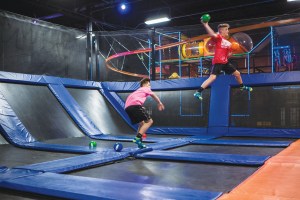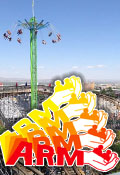Expanding company adds other activities to the family fun mix
AT: Tim Baldwin
BEDFORD, Texas — One of the most recent trends in interactive family recreation is the indoor trampoline park. It is an attractions industry niche that has been expanding rapidly over the past decade.
 For its part, Urban Air Adventure Parks is going full speed to keep things… well, bouncing along. As the company expands, it is finding new ways to not only excite customers, but to add spring to the business itself.
For its part, Urban Air Adventure Parks is going full speed to keep things… well, bouncing along. As the company expands, it is finding new ways to not only excite customers, but to add spring to the business itself.
Michael Browning, CEO of Urban Air, actually finds the “trampoline” label to not be the ideal description anymore.
“When we opened, we were about 80 percent trampolines; now it is 20 percent or less,” he said. “We quickly had the vision that it could be faddish. Having one attraction was like owning only one stock in your stock portfolio. You’re not diversified, you’re not well positioned for any type of market changes.
 “We felt the trampoline park didn’t provide the customer the overall experience they were looking for. So, we started innovating the space.”
“We felt the trampoline park didn’t provide the customer the overall experience they were looking for. So, we started innovating the space.”
Urban Air is the largest adventure park operating company. Launched in 2011, it currently has 60 facilities in operation, with 84 under construction and an additional 56 being negotiated.
To keep its offerings fresh, Urban Air installed obstacle courses — marketed as the Urban Warrior Course — similar to those seen in television shows such as American Ninja Warrior. The success of the course spurred the company to add rock climbing walls, indoor soft-play structures, ropes courses and more.
Browning felt the additions took the facilities to the next level. “We’ve broadened our demographic,” he said. “We get a lot more corporate events, singles nights, date nights and church outings because the attractions are more conducive to that type of thing.”
 Urban Air terms its parks 1.5 or 2.0, depending upon their size. As the annual trade show hosted by the International Association of Amusement Parks and Attractions gets underway in Orlando, new facilities termed 3.0 will be opening that include indoor go-kart tracks and indoor skydiving. The smallest facility is 21,000 square feet and the largest is 85,000 square feet; Browning estimates the average location is around 40,000-50,000 square feet.
Urban Air terms its parks 1.5 or 2.0, depending upon their size. As the annual trade show hosted by the International Association of Amusement Parks and Attractions gets underway in Orlando, new facilities termed 3.0 will be opening that include indoor go-kart tracks and indoor skydiving. The smallest facility is 21,000 square feet and the largest is 85,000 square feet; Browning estimates the average location is around 40,000-50,000 square feet.
Urban Air is looking at former Toys R Us and Sears store locations for future expansion possibilities. The large, vacant existing spaces provide opportunities for what Browning called “speed to market.”
“We’ll be the only company other than iFly with indoor skydiving,” he said. “Our business model is to provide an active entertainment experience for the consumer that is very valuable. We don’t have to rely on any one attraction to be what they are coming for.”
With the variety of activities, “you don’t leave until you’re worn out,” Browning added with a laugh.
 Urban Air’s facilities average about 180,000 guests per location annually, and the company is expecting a year-end total of 23 million guests in 2018. The attendance numbers do not include spectators, such as parents and grandparents; while some elect to play along with their kids, not all actively engage in the attractions.
Urban Air’s facilities average about 180,000 guests per location annually, and the company is expecting a year-end total of 23 million guests in 2018. The attendance numbers do not include spectators, such as parents and grandparents; while some elect to play along with their kids, not all actively engage in the attractions.
A perk for parents is a substantial discount when a regular ticket is purchased for a child. “We’re going from a zero-dollar transaction to $5.99,” Browning said. “We believe when a parent and a child interact on our attractions, it creates lasting memories and builds brand equity and customer loyalty, and they come back more.”
In June, Urban Air brought on Jay Thomas, a 30-year-plus veteran of Six Flags. In his role as chief commercial officer, Thomas is leading the company’s commercial strategy as well as developing and optimizing all Urban Air facilities.
 “The pure growth of Urban Air and what Urban Air represents is exciting,” Thomas told Amusement Today. “We are the innovators of indoor adventure park space. We are the creators of that model. Getting my hands on the overall operation of the organization is something that is right up my alley.”
“The pure growth of Urban Air and what Urban Air represents is exciting,” Thomas told Amusement Today. “We are the innovators of indoor adventure park space. We are the creators of that model. Getting my hands on the overall operation of the organization is something that is right up my alley.”
“We were thrilled to have Jay join the team,” Browning said. “He brings an enormous amount of industry knowledge to Urban Air, and he is responsible for developing new attractions and content ahead of the competition while maximizing gross revenue at all the touchpoints.”
“We have aspirational targets — we want to have 300 parks by 2020 and 600 by 2022,” Thomas said. “A lot of our growth is coming from franchisees that are opening their second, third or fourth locations.”
In trying to remain innovative, Urban Air looks at each location for what attractions will work best in that specific space along with the base attractions. Indoor go-karting, miniature golf, bumper cars, bowling, laser tag and virtual reality are among the options available for placement in each market.
Looking ahead, Urban Air is developing innovative technology-based attractions, currently in beta testing, that it hopes to launch next summer.
This article appears in the NOV II 2018 issue of Amusement Today.















